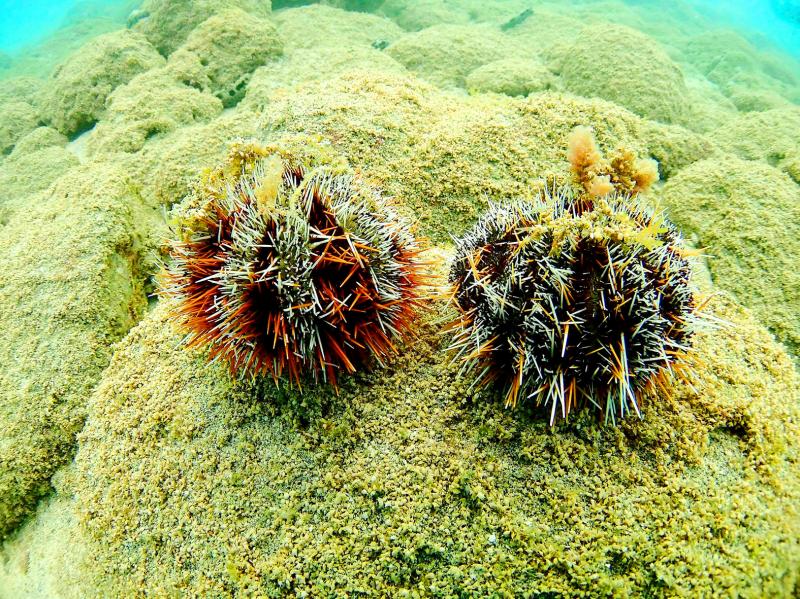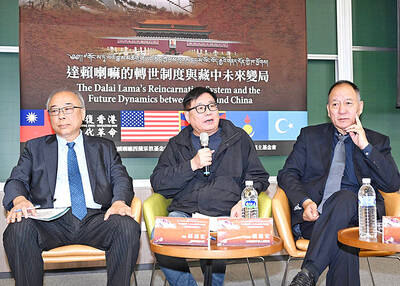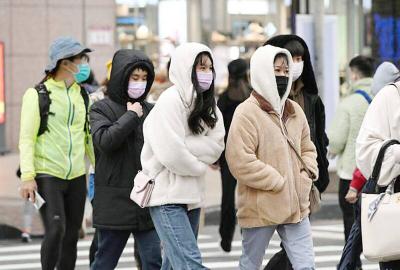Conservationists on Wednesday urged the Penghu County Government to ban the capture of Hemicentrotus pulcherrimus sea urchins.
The Maritime Citizen Foundation and the Environment and Animal Society of Taiwan said that their volunteer divers only found two specimens — near Jianshan (尖山) — when they surveyed the waters near the archipelago.
The groups estimated that the number of sea urchins living in the area has fallen from 200 million about 50 years ago to about 50,000 today.

Photo courtesy of the Maritime Citizen Foundation and the Environment and Animal Society of Taiwan
Even though whole sea urchins have largely disappeared from local markets, some fishers might catch them illegally, they said.
The county government’s conservation efforts are understaffed and therefore cannot enforce the regulations in place, foundation director-general Wang Hsiao-chan (王曉嬋) said.
If Penghu does not enact a ban soon, the maritime ecosystem off its coast would collapse, Wang said.
Society deputy director-general Chen Yu-min (陳玉敏) said that an efficient sea urchin conservation scheme would include fishing licenses that define quotas and a cap on the number of sea urchins that can be caught per year in a defined area.
An efficient scheme would also restrict when and where sea urchins can be caught, and what kind of boats fishers can use, Chen said.
Even though Penghu in 2007 set some restrictions, the local sea urchin population continued to decline sharply until at least 2018, when the county government shortened the fishing season from four months to two months, she said.
However, the restrictions do not restrict the area for fishing, and do not require fishers to obtain licenses and that they disclose how many sea urchins they have caught, she said, adding that those shortcomings render the current conservation scheme unenforceable.
Sea urchins are in such high demand that the whole adult population is usually depleted half a month after the season starts, she said.
A better protection scheme for sea urchins, which feed on seaweed, would also increase coral reef health, Chen added.
She said Penghu should emulate a scheme Pingtung County in 2005 implemented in Kenting National Park, where a survey in 2017 showed that there were on average 16.8 sea urchins per square meter, nearly matching its record sea urchin population density of 17 animals per square meter in 1984.
Sea urchin fishing should be banned off Penghu and people should refrain from eating the animals, the groups said.

ALIGNED THINKING: Taiwan and Japan have a mutual interest in trade, culture and engineering, and can work together for stability, Cho Jung-tai said Taiwan and Japan are two like-minded countries willing to work together to form a “safety barrier” in the Indo-Pacific region, Premier Cho Jung-tai (卓榮泰) yesterday said at the opening ceremony of the 35th Taiwan-Japan Modern Engineering and Technology Symposium in Taipei. Taiwan and Japan are close geographically and closer emotionally, he added. Citing the overflowing of a barrier lake in the Mataian River (馬太鞍溪) in September, Cho said the submersible water level sensors given by Japan during the disaster helped Taiwan monitor the lake’s water levels more accurately. Japan also provided a lot of vaccines early in the outbreak of the COVID-19 pandemic,

Kaohsiung Mayor Chen Chi-mai (陳其邁) on Monday announced light shows and themed traffic lights to welcome fans of South Korean pop group Twice to the port city. The group is to play Kaohsiung on Saturday as part of its “This Is For” world tour. It would be the group’s first performance in Taiwan since its debut 10 years ago. The all-female group consists of five South Koreans, three Japanese and Tainan’s Chou Tzu-yu (周子瑜), the first Taiwan-born and raised member of a South Korean girl group. To promote the group’s arrival, the city has been holding a series of events, including a pop-up

TEMPORAL/SPIRITUAL: Beijing’s claim that the next Buddhist leader must come from China is a heavy-handed political maneuver that will fall flat-faced, experts said China’s requirement that the Dalai Lama’s reincarnation to be born in China and approved by Beijing has drawn criticism, with experts at a forum in Taipei yesterday saying that if Beijing were to put forth its own Dalai Lama, the person would not be recognized by the Tibetan Buddhist community. The experts made a remarks at the two-day forum hosted by the Tibet Religious Foundation of His Holiness the Dalai Lama titled: “The Snow Land Forum: Finding Common Ground on Tibet.” China says it has the right to determine the Dalai Lama’s reincarnation, as it claims sovereignty over Tibet since ancient times,

Temperatures in some parts of Taiwan are expected to fall sharply to lows of 15°C later this week as seasonal northeasterly winds strengthen, the Central Weather Administration (CWA) said today. It is to be the strongest cold wave to affect northern Taiwan this autumn, while Chiayi County in the southwest and some parts of central Taiwan are likely to also see lower temperatures due to radiational cooling, which occurs under conditions of clear skies, light winds and dry weather, the CWA said. Across Taiwan, temperatures are to fall gradually this week, dropping to 15°C to 16°C in the early hours of Wednesday